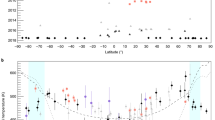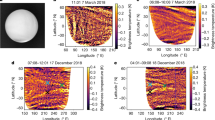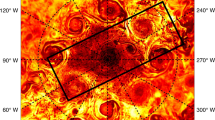Abstract
Since the discovery of a cloud of neutral sodium atoms accompanying the jovian satellite, Io, in its orbit1, asymmetries of part of the cloud (region B)2 have often been noted3–6. Brightness variations with orbital longitude3,4 and asymmetries found by comparing images taken at orbital longitudes differing by 180° (ref. 5) have been explained as effects of solar radiation pressure7. Given that the vast majority of neutrals precede Io in its orbit, and that sputtering of Io is the principal source mechanism, Matson et al.8 postulated a hemispherical source centred 60° towards the sub-Jupiter point from the centre of the leading hemisphere to explain the general cloud shape. However, soft collisions with plasma ions may be important and call for a reassessment9. I show here that, given reasonable assumptions, the east–west brightness asymmetry can be explained by temporal changes in the number of emitting atoms in the cloud caused by atmospheric shielding of the surface.
This is a preview of subscription content, access via your institution
Access options
Subscribe to this journal
Receive 51 print issues and online access
$199.00 per year
only $3.90 per issue
Buy this article
- Purchase on Springer Link
- Instant access to full article PDF
Prices may be subject to local taxes which are calculated during checkout
Similar content being viewed by others
References
Brown, R. A. in Exploration of the Planetary System (eds Woszczyk, A. & Iwaniszewska, C.) 527–531 (Reidel, Hingham, 1974).
Brown, R. A., Goody, R. M., Murcray, F. J. & Chaffee, F. H. Astrophys. J. 200, L49–L53 (1975).
Bergstralh, J. T., Matson, D. L. & Johnson, T. V. Astrophys. J. 195, L131–L135 (1975).
Bergstralh, J. T., Young, J. W., Matson, D. L. & Johnson, T. V. Astrophys. J. 211, L51–L55 (1977).
Goldberg, B. A., Garneau, G. W. & LaVoie, S. K. Science 226, 512–516 (1984).
Murcray, F. J. & Goody, R. M. Astrophys. J. 226, 327–335 (1978).
Smyth, W. H. Astrophys. J. 234, 1148–1153 (1979).
Matson, D. L., Goldberg, G. A., Johnson, T. V. & Carlson, R. W. Science 199, 531–533 (1978).
Brown, R. A., Pilcher, C. B. & Strobel, D. F. in Physics of the Jovian Magnetosphere (ed. Dessler, A. J.) 197–225 (Cambridge University Press, 1983).
Matson, D. L. & Nash, D. B. J. geophys. Res. 88, 4771–4783 (1983).
Johnson, R. E., Garret, J. W., Boring, J. W., Barton, L. A. & Brown, W. L. J. geophys. Res. 89, B711–B715 (1984).
Kumar, S. J. geophys. Res. 89, 7399–7406 (1984).
Cheng, A. F. J. geophys. Res. 89, 3939–3944 (1984).
Kumar, S. Icarus 61, 101–123 (1985).
Kliore, A. J. et al. Icarus 24, 407–410 (1975).
Kliore, A. J. IAU Colloq. 57 (1980).
Minton, R. B. Commun. lunar planet. Lab. 10, 35–39 (1973).
Pearl, J. et al. Nature 280, 755–758 (1979).
Fanale, F. P., Banerdt, W. B., Elson, L. S., Johnson, T. V. & Zurek, R. W. in The Satellites of Jupiter (ed. Morrison, D.) 756–781 (University of Arizona Press, Tucson, 1982).
Honig, R. E. & Hook, H. O. RCA Rev. 21, 360–368 (1960).
Kumar, S. & Hunten, D. in The Satellites of Jupiter (ed. Morrison, D.) 782–806 (University of Arizona Press, Tucson, 1982).
Cummings, W. D., Dessler, A. J. & Hill, T. W. J. geophys. Res. 85, 2108–2114 (1980).
Nash, D. B. & Johnson, T. V. Icarus 38, 69–74 (1979).
Moore, M. H. Icarus 59, 114–128 (1984).
Radford, H. E. & Rice, F. O. J. chem. Phys. 33, 774–776 (1960).
Young, A. T. Icarus 58, 197–226 (1984).
Soderblom, L. A. et al. Geophys. Res. Lett. 7, 963–966 (1980).
Howell, R. R., Cruikshank, D. P. & Fanale, F. P. Icarus 57, 83–92 (1984).
Nelson, R. M. et al. Science 210, 784–786 (1980).
Shemansky, D. E. Astrophys. J. 236, 1043–1054 (1980).
Trafton, L. & Macy, W. Astrophys. J. 215, 971–976 (1977).
Bagenal, F. & Sullivan, J. D. J. geophys. Res. 86, 8447–8466 (1981).
Author information
Authors and Affiliations
Rights and permissions
About this article
Cite this article
Thomas, N. An explanation of the east–west asymmetry of Io's sodium cloud. Nature 322, 343–345 (1986). https://doi.org/10.1038/322343a0
Received:
Accepted:
Issue Date:
DOI: https://doi.org/10.1038/322343a0
This article is cited by
-
Optical observations of Io's neutral clouds and plasma torus
Surveys in Geophysics (1992)
Comments
By submitting a comment you agree to abide by our Terms and Community Guidelines. If you find something abusive or that does not comply with our terms or guidelines please flag it as inappropriate.



